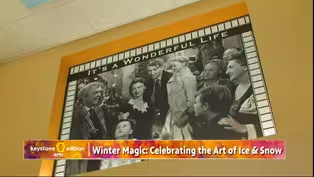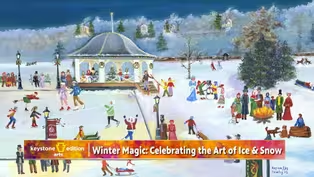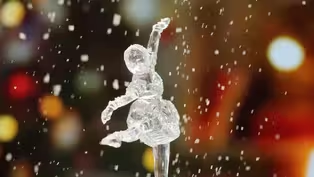Keystone Edition
History of the Snowman - Bob Eckstein
Clip: 12/23/2024 | 7m 35sVideo has Closed Captions
Bob Eckstein shares the history of the snowman in popular culture
Bob Eckstein shares the history of the snowman in popular culture
Problems playing video? | Closed Captioning Feedback
Problems playing video? | Closed Captioning Feedback
Keystone Edition is a local public television program presented by WVIA
Keystone Edition
History of the Snowman - Bob Eckstein
Clip: 12/23/2024 | 7m 35sVideo has Closed Captions
Bob Eckstein shares the history of the snowman in popular culture
Problems playing video? | Closed Captioning Feedback
How to Watch Keystone Edition
Keystone Edition is available to stream on pbs.org and the free PBS App, available on iPhone, Apple TV, Android TV, Android smartphones, Amazon Fire TV, Amazon Fire Tablet, Roku, Samsung Smart TV, and Vizio.
Providing Support for PBS.org
Learn Moreabout PBS online sponsorshipBob Eckstein of New York City and Lake Ariel happens to be the world's foremost Snowman expert.
He's author of the celebrated "Illustrated History of the Snowman," also the New York Times bestseller, "Footnotes from the World's Greatest Bookstores."
He's a New Yorker cartoonist.
His op-eds, stories, and cartoons appear regularly in the New York Times, the New York Daily News, the Wall Street Journal, among many other places.
Mary Beth Voda is an author, teacher, an independent historian whose articles have appeared in Pennsylvania Heritage, Susquehanna Life, American History, World War II Chronicles, and more.
Welcome, Mary Beth, welcome, Bob.
We wanna talk snow.
You, Bob, take snowmen very seriously, though you do have fun with them.
You've traveled around the world to learn their stories.
How and why?
- Because it's really our first selfie.
And it snowed today.
I hope people are getting excited.
I know some people are not excited about seeing the snow.
Maybe we could turn their opinion around after the show.
But I traveled the world for about seven years, tried to learn who made the first Snowman.
It's something that was an activity we shared with our ancestors in prehistoric times.
And I found that out by going to experts in the subject of archeology and cultural history to learn that the Snowman is actually something that's been with us for a very, very long time.
- And you found an image that a monk may have created in the 14th century, did you?
- Yes, it's the first real hard evidence of an illustration of a Snowman.
It's found in the margins of an illuminated manuscript, "The Book of Hours."
It was done around 1380, and this was done, well, I'm not really sure, but I suspect it's around Brussels, Belgium.
And it's actually alongside a solemn passage of Jesus Christ, so it's really unexpected.
But that is the case with the Snowman whose history is filled with dark secrets.
And there's all different crazy events that happened in his past, such as the miracle of 1511, which is an amazing story, as well as the massacre of 1691, one of the bloodiest events in American history.
You can't leave us there.
What happened?
- In the case of the American history story, it was a case of, excuse me, it was a case of a Fort Schenectady, it was gonna be attacked by the French soldiers who were marching down from Montreal.
And they came up to the fort and found it in a blizzard at midnight and the gates were frozen open from the blizzard.
And instead of two guards at their posts, instead there were two snowmen to greet their attackers.
And it was a horrific event.
But it is also a horrible event in the Snowman's history as well.
- Yeah, speaking of those ages, the old manuscript, "The Illuminated Man," you tell us that the great Michelangelo, the artist who did the Pieta and the Sistine Chapel built a Snowman.
Now what?
- Yeah, it's true, it was 1494 that he was commissioned as a teenager to create a Snowman for a party for a palace in Florence.
And this is not so unusual that famous artists did create art out of snow.
I mean, for a lot of people, it was free art supplies dropped on their doorstep when it snowed.
And for a time in the Middle Ages, this would be an activity that was very popular.
Instead of watching TV or movies, people would stroll through the streets in the early evening in town and they would see what creations people made in the street corners.
And they wouldn't just do like children's play, but this would sometimes be political commentary or even sometimes some kind of a statement they're making against the church or the government.
This was their form of expression.
And so it wasn't until Frosty came along that we all think of Snowman-making as children's play.
It used to be something that was a serious art form.
- Well, do we go into galleries or the Metropolitan Museum of Art and see snowmen?
I mean, are there artists?
- There are, there's actually some major artists who are doing that, such as at the Met, there's a frozen Snowman.
It's actually coming from MoMA and it originally came from the Art Institute of Chicago, and that's the Snowman that's in the refrigerator.
And it's making a political statement now.
But Peter, the artist, his name is Fishy, and he also worked with a partner to make this installation.
Initially it was just a commission and they made this installation.
But it has since become sort of a poster boy for global warming and the fact that what's gonna keep the Snowman alive going forward?
- Well, we know if we have seen, you mentioned Frosty, so we know there's a "Frosty the Snowman" movie.
We know there's a "Jack Frost," we know there's a thriller, "The Snowman."
But you tell us a story about one of the much loved movies of all times, "Citizen Kane."
What's the story of the Snowman in "Citizen Kane?"
- Well I contend that the Snowman's always in some kind of pivotal sort of a benchmark in history, like a frozen "Forrest Gump."
He always winds up being like right there in the advent of things like inventions like the first postcards and magazines and the first silent movies.
And sure enough, why not be in one of the most acclaimed movies ever in cinema, "Citizen Kane."
And not only that, being the most pivotal scene in the movie in which the mother is inside signing away her son as her son's making a Snowman out front.
And there's Orson wells using symbolism, using the Snowman to represent childhood and the loss of innocence, and then also using the device of it snowing.
And a lot of times in movies, snow is used to signify a magical moment or a turning point or just to emotionally grab you.
And it does that, I think when it snows, even not just in movies, but in real life, people do feel a special something when it starts to snow.
- Well you have some information in the book about how the movie snow was made for "Citizen Kane."
- Exactly, he had to think of a way of how he was gonna film and they had to come up with new ways.
And Citizen Kane had some state-of-the-art advancements in cinema.
And Orson Welles has done a lot of unusual things.
And in this case, he used painted snowflakes to create the snow in "Citizen Kane."
- Corn Flakes.
- Corn Flakes.
- Corn Flakes.
Painted corn flakes.
- And it's funny, snow has always been used in advertising and signified things like salt and flour and dandruff even.
And the Snowman would be the pitchman they would use when in the 11th hour they couldn't find someone else to sell their product.
And so the Snowman actually was in the forefront of advertising, and it just goes to show you never can get rid of the Snowman.
- Well what's so amazing to me is
It's a Wonderful Life - Mary Beth Voda
Video has Closed Captions
Clip: 12/23/2024 | 7m | Mary Beth Voda shares the local connection to the film It's A Wonderful Life (7m)
Preview: 12/23/2024 | 30s | Watch Monday, December 23rd at 7pm on WVIA TV (30s)
Providing Support for PBS.org
Learn Moreabout PBS online sponsorship
- News and Public Affairs

Top journalists deliver compelling original analysis of the hour's headlines.

- News and Public Affairs

FRONTLINE is investigative journalism that questions, explains and changes our world.












Support for PBS provided by:
Keystone Edition is a local public television program presented by WVIA


